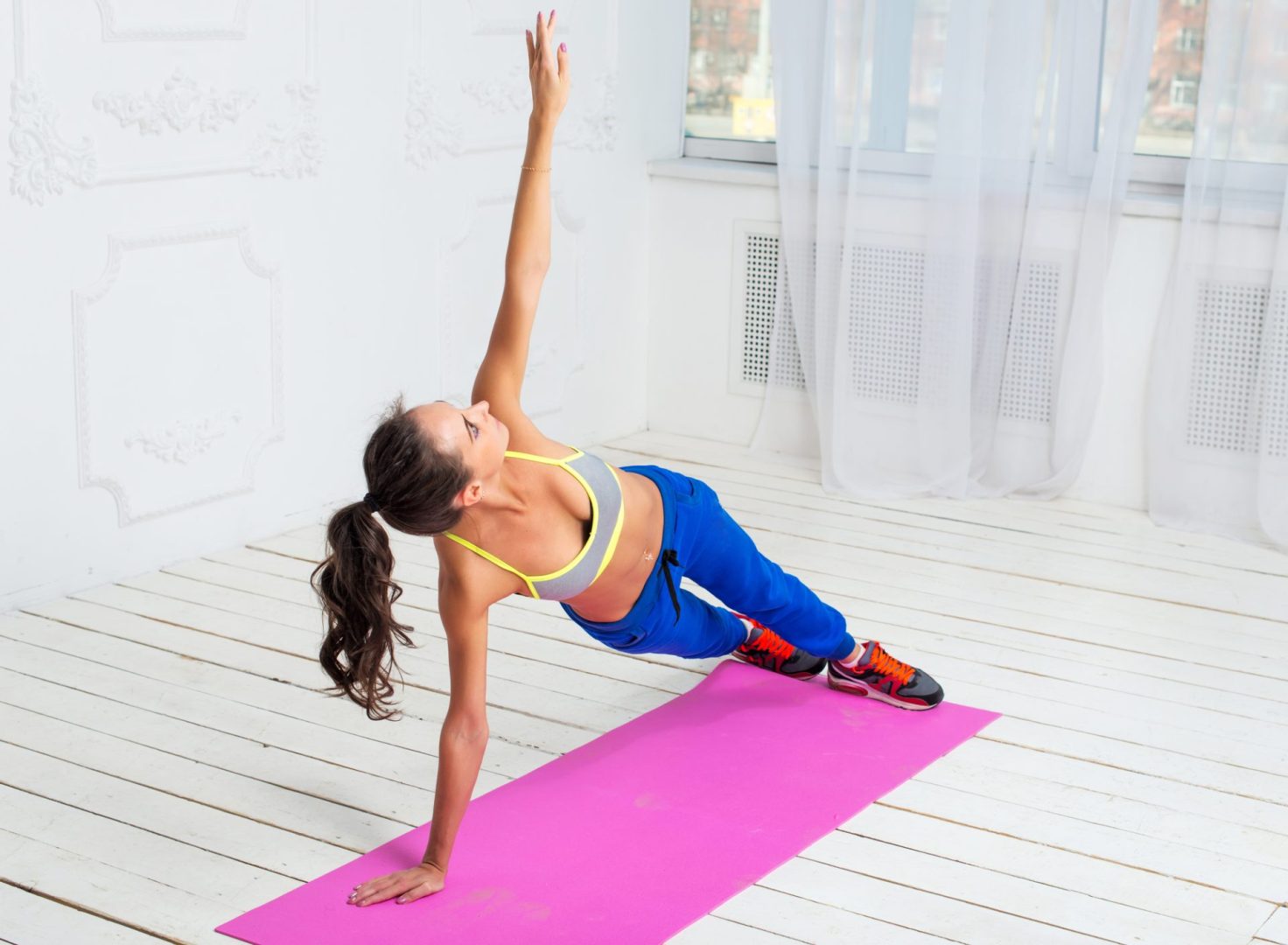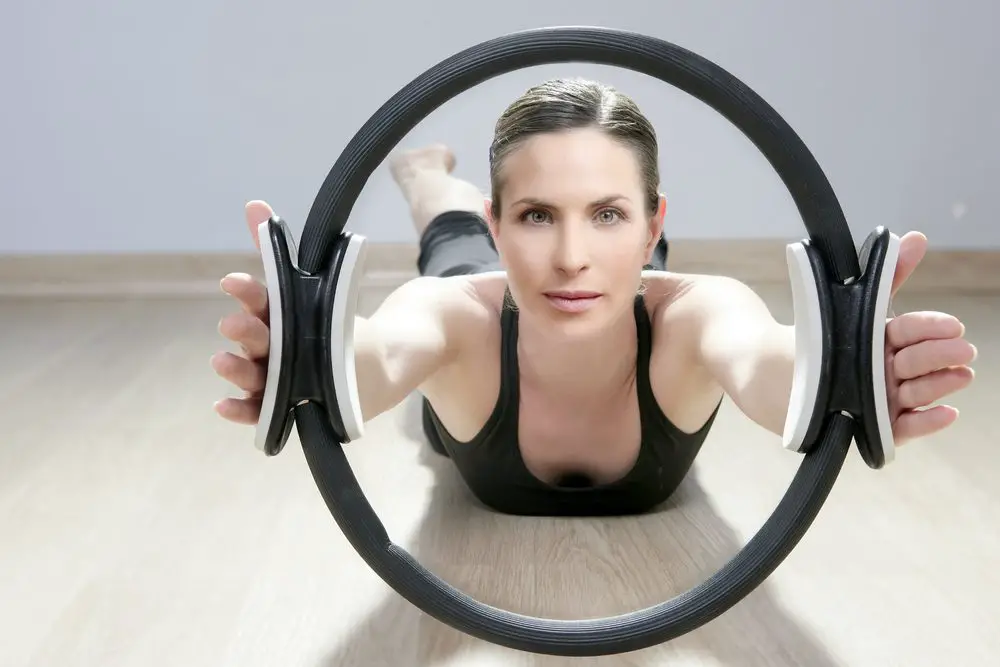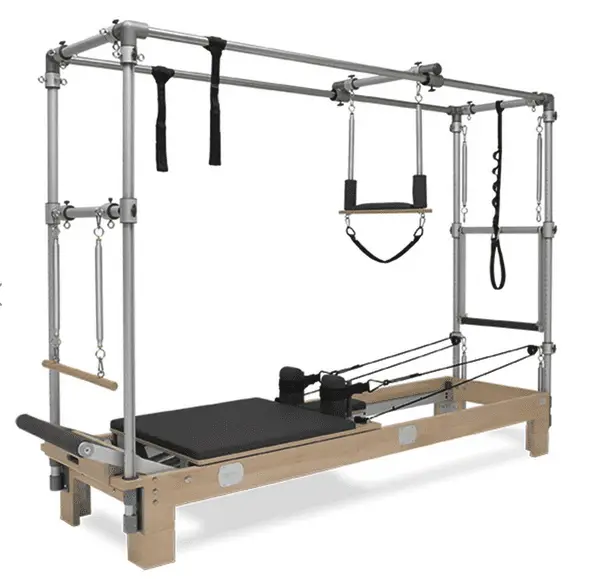Equipment
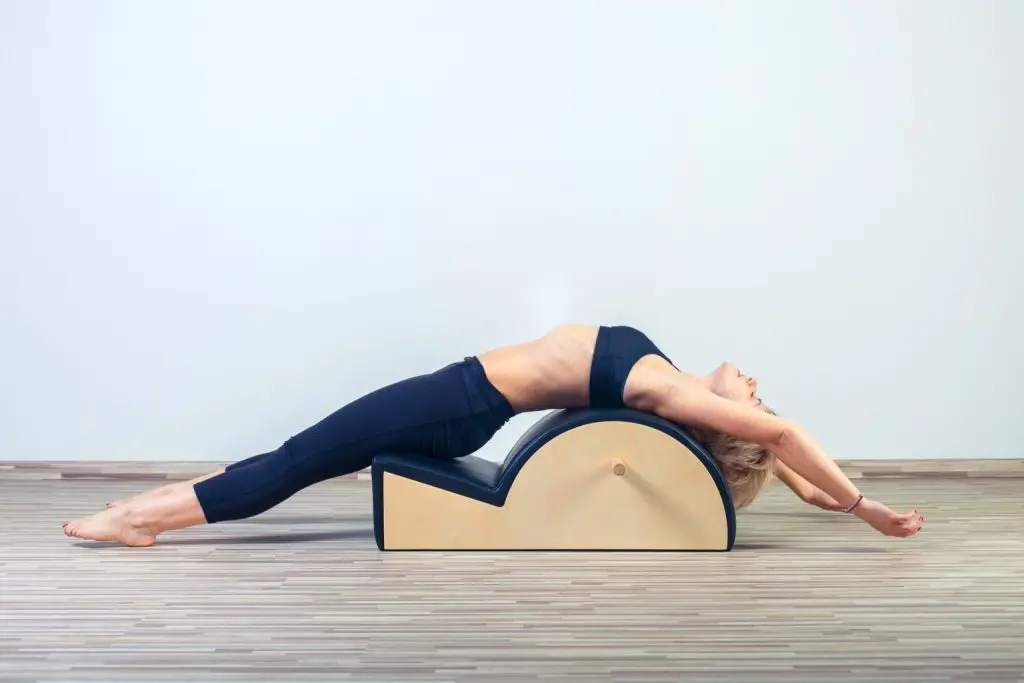
Pilates Back Posture Correctors
Pilates, formed in the 1900’s by Joseph Pilates is a low impact body workout. Working to tone and strengthen those muscles without the risks of other sports.
This workout is perfect for anyone regardless of your age, body type or fitness level. It has quickly become a modern day trend for those looking for a low impact, high result workout.
All of the benefits without the stress of joint pain, injury or a mass of equipment. Pilates can be done at home or more favorably in a studio.
Along with toned muscles, increase in strength and overall health, pilates offers something everyone can benefit from. Posture correction.
After days of sitting in chairs, hunched over computers, we could all use a little posture correction. But what equipment do you need?
Keep reading to find out the top pilates posture correctors. Whether you have severe back pain or just want to stand a little taller, this guide will help you discover what posture corrector you need to up your pilates workout.
Origin of the Posture Corrector
Making training equipment out of everyday materials was nothing new for Joseph Pilates. He was born in Germany in the late 1800s and became interested in bodybuilding to better his health and appearance.
Pilates enhanced his health and strength through a combination of boxing, weightlifting, and martial arts, leading to a lifetime belief in the benefits of exercise.
During the 1902’s, Pilates had infiltrated the United States. As the body weight phenomenon grew, the equipment needed to support the training became more inventive.
Along came the Pilates Chair, the Cadillac, the Wunda Chair, the Guillotine and the Tower. All used for specific movements and areas of the body. The one we are focusing on today is the Step Barrel.
Aside from its history, the step barrel is an excellent piece of equipment for any Pilates practitioner or anyone looking to improve their physical fitness and quality of life.
The results you’ll get from this piece of equipment may appear simple, but the investment will be well worth it. Working out on an arc allows you to bend your body and target muscles that you wouldn’t be able to target otherwise.
Pilates Posture Corrector Specifications
Now you know the beginning of pilates and the creation of the step barrel but what does it do? Why do pilate practitioners use them?
Although its name implies that it is only an appliance for correcting poor posture, a posture corrector has other advantages.
In fact, because all Pilates exercises are designed to improve posture and spinal alignment, the posture corrector can be thought of as yet another tool in the Pilates toolbox.
The posture corrector can help you restore the natural curve of your spine, relieve back discomfort, and enhance your balance.
It can also help you stretch your back muscles to improve flexibility and give you a structure to execute particular strengthening exercises for core strength and overall health.
It’s also useful for yoga practice, recuperation, and personal training. Overall, a step barrel is a great complement to any Pilates workout.
When it comes to your workout, there isn’t much of a difference between the various arcs, handle options, and materials. You will, however, most likely have a preference for a specific arc that best matches your back’s natural curve.
When purchasing an arc barrel, think about how long it will last, how well it will fit your body, and your own preferences for manufacturing materials and grips.
Make sure you do your homework before making a purchase. If feasible, test out a few different barrel models at a nearby Pilates studio to see which one best suits your needs.
The Step Barrel vs The Ladder Barrel
It is beneficial to compare the different barrels utilized in the Pilates approach for those who are just starting out. Pilates practitioners use two different types of barrels to support their technique. The above-mentioned step barrel and the ladder barrel are the two mechanisms.
The ladder barrel, as its name implies, is constructed out of a raised half-barrel fixed on a frame, next to a ladder with multiple rungs. The ladder barrel’s form, like that of the step barrel, provides for stretching and strengthening of the back muscles, spine, neck, and core muscles.
The ladder’s rungs are designed to keep the body stable while performing a set of movements. Depending on the area of the body you’re addressing, you can attain this stabilization by either grasping the rungs with your hands or interlacing your feet.
This piece of equipment can be adjusted to fit people of all heights and builds, and it should give anyone a good exercise.
You are unlikely to mix the two when purchasing equipment for your home. Although ladder barrels are substantially larger than step barrels and are often exclusively found in Pilates studios.
The Barrel family includes the Step Barrel, Spine Corrector, and Half Barrel.
The semicircular component of the Step Barrel is of a medium size
1. AeroPilates Spine Corrector Barrel
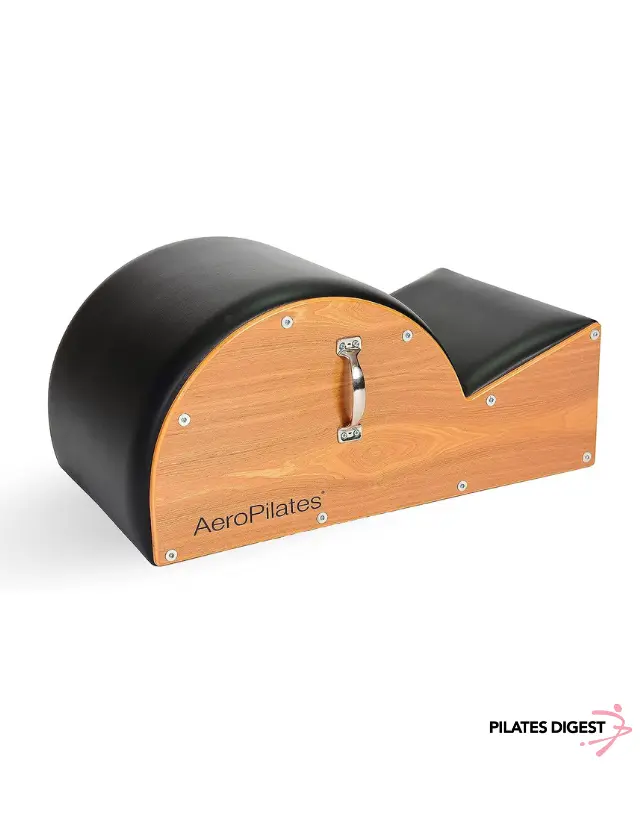
Improve your posture and experience full-body toning with the AeroPilates Spine Corrector Barrel. Crafted from quality hardwood, foam, and vinyl, this equipment is not only durable but comfortable, ensuring you can focus on your workouts and not on discomfort.
The Spine Corrector Barrel is specifically designed to support the restoration of your spine’s natural curve. As a potent posture corrector, it serves as an effective back stretcher that opens your spine, encouraging proper posture and facilitating easier, deeper breathing. This tool plays a significant role in helping you reduce pressure on your spine, allowing you to move and feel better.
But the benefits don’t stop at spinal support. The AeroPilates Spine Corrector Barrel also enables a full-body strength workout, making it a multifaceted pilates equipment. Use it to strengthen your abs, back, and shoulder muscles, all while supporting your spine. It also tones your thigh and core stabilizer muscles, rounding out a complete body workout.
Ease of use and comfort are integral features of this device. It comes with a padded, upholstered vinyl surface designed for comfort and relaxation no matter what pose you’re in. Even better, this lightweight pilates arc barrel is outfitted with a built-in carrying handle, making it portable and easy to use wherever you go.
To ensure you get the most out of your Spine Corrector Barrel, it comes with a pilates DVD as well as videos on demand. These resources demonstrate the correct usage and form for the Posture Corrector, directed in a safe and guided manner. You’ll be led in a 20-minute workout by master Pilates instructor Romana Kryzanowska and AeroPilates elite trainer Marjolein Brugman, promising the best fitness experience right at your fingertips.
Advantages:
- Supports restoration of spine’s natural curve for improved posture.
- Provides full-body strength workout, including core and thigh toning.
- Facilitates deeper, easier breathing by opening the spine.
- Offers comfortable, padded surface for any pose.
- Includes instructional DVD and on-demand videos for proper usage.
- Portable design with a built-in carrying handle for convenience.
You can see this pilates back posture corrector here
2. AeroPilates Precision Series Spine Corrector
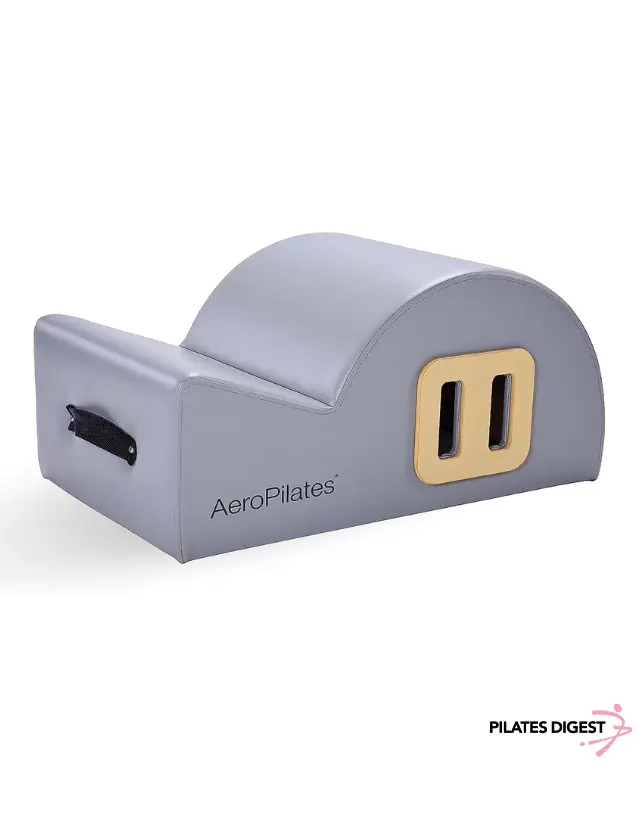
The AeroPilates Precision Series Spine Corrector is a comprehensive solution designed to correct your posture and improve your overall health. This remarkable product offers an effective and straightforward way to restore your spine’s natural curve, assisting in promoting appropriate posture and easier breathing.
Moreover, the Spine Corrector Barrel is not just about posture correction; it’s also a powerful fitness tool for full-body workouts. The device allows you to strengthen your abs, back, shoulder muscles in support of the spine. It also tones your thigh and core stabilizer muscles, thereby ensuring a comprehensive full-body toning.
One of the key design features of this Spine Corrector is its focus on facilitating deeper, more comfortable breathing. By opening your spine and chest and elongating the spine, it helps to reduce pressure, thereby enhancing your overall movement and feeling of wellness.
Comfort and portability are two essential aspects of this back stretcher. It is designed with a padded, upholstered vinyl surface that provides optimal comfort and relaxation regardless of the pose you are performing. It is lightweight and comes with a built-in carrying handle for ease of use and transport.
The Spine Corrector also includes two expert-guided online workout videos to ensure you make the most out of this tool. AeroPilates expert Shauna Smith-Yates leads you in a Level 1 Workout and Back Care Routine, demonstrating the proper usage and form for a safe, directed Pilates workout.
Advantages:
- Restores natural spine curve, promoting better posture and breathing.
- Strengthens abs, back, and shoulder muscles for spinal support.
- Tones thigh and core stabilizer muscles for full-body toning.
- Padded, upholstered vinyl surface ensures comfort during use.
- Lightweight and portable, includes built-in carrying handle.
- Includes expert-guided online workout videos for safe, effective use.
You can see this pilates back posture corrector here
3. Stott Pilates Merrithew Spine Corrector
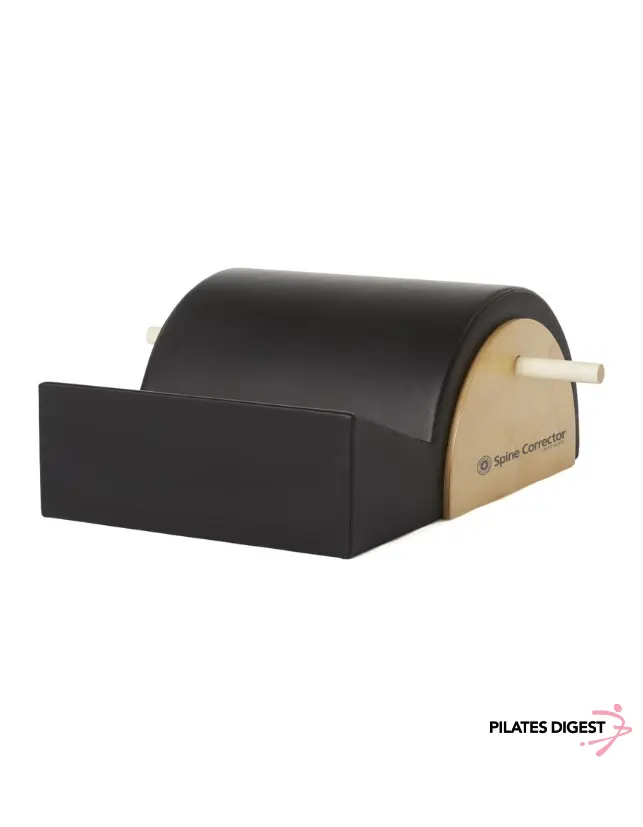
The Stott Pilates Merrithew Spine Corrector is an outstanding tool designed to correct or restore the spine’s natural curve. Measuring 21.5 inches wide, 30.75 inches long, and 12 inches high, and weighing 24 pounds, it’s a versatile and robust piece of equipment to enhance your home or studio Pilates practice.
This Spine Corrector is made from solid Baltic Birch panels, ensuring a sturdy construction that can withstand consistent use over time. It is also equipped with Maple handgrips for added comfort and support during your workout.
In addition to its durable construction, this unit features dense EVA foam padding, providing you with the maximum comfort during exercises, even in positions that put pressure on sensitive areas. The foam is resilient, maintaining its shape over time while also delivering the cushioning necessary for safe and effective Pilates exercises.
Some assembly is required for this product. You’ll need to attach a predrilled dowel on the installed brackets, but all necessary screws are supplied, making the assembly process straightforward and hassle-free.
Whether you’re a beginner just starting out or an experienced practitioner looking to deepen your practice, the Stott Pilates Merrithew Spine Corrector can help you achieve a healthier spine and a stronger body.
Advantages:
- Corrects or restores the spine’s natural curve for improved posture.
- Constructed from solid Baltic Birch and Maple for durability.
- Dense EVA foam padding ensures maximum comfort during workouts.
- Easy assembly with predrilled dowels and supplied screws.
- Compact design fits conveniently in home or studio spaces.
- A versatile tool, suitable for both beginners and advanced practitioners.
You can see this pilates back posture corrector here
Exercises for Posture Improvements
Now that you know the basics when looking for a spine corrector to add to your collection, what moves can you use it for?
Below are some moves that will get you started on your pilates journey. Whether you have basic skills or know nothing other than lying on the ground to stretch out your back, try some of these exercises and you’ll start seeing improvements!
Spinal Extension
There are a range of exercises which fit into the spinal extension umbrella. With, of course, a focus on stretching the spine and opening the chest. We’ll focus on the beginner movements.
- To begin, find a comfortable sitting position on the step of the barrel with your back straight.
- Slowly reach your arms out, bending forward slighting to fully stretch the spine forward, raising your arms up above your head and begin rolling your back on the barrel. Ensuring to take the shape of the barrel.
- Inhale as you stretch.
- Once fully extended back, slowly bring your arms back to your front through the sides as you find your seating position.
- Repeat for up to 8 reps.
Lip Abdominals
You find some discomfort within your lower back throughout pilate workouts, this is due to a lack of muscle. Lip Abdominals focus on strengthening those lower back muscles to give you a stronger core.
- Start by sitting at the edge of the step. Knees bent comfortably and feet spread hip-distance apart.
- Keeping your palms facing each other, extend your arms out in front of your chest at shoulder height. Take a nice deep breath.
- Exhale as you begin rolling your spine back to the barrel, tightening your core muscles or abs.
- As you inhale, use your abdominal muscles to bring you upright.
- Repeat this exercise for up to 8 reps.
Well Abdominals
Again we are focusing on those core muscles with a nice, deep spinal stretch. Extending the mobility of your spine and giving your core muscles a workout.
- Find a comfortable sitting position on the step, hips and back resting lightly against the arch of the barrel.
- Knees should be bent with your heels touching.
- Place your hands behind your head, deep breath in and exhale as you slowly roll back onto the barrel. Keeping to the shape of the barrel.
- As you begin to inhale, you should feel your back begin to extend down the arc of the barrel.
- Slowly exhale and begin your ascent to your upright position.
- Repeat for up to 10 reps.
Remember to hold this position for a few seconds to fully let your spine decompress within the stretch.
Side Bend
This exercise is great for stabilizing the pelvis and increasing spinal flexibility.
- Sit sideways on the step. The barrel should be on your right side and hook your right leg onto the step for extra balance.
- Keep your left leg straight.
- Sitting tall with your arms outstretched, inhale and pull your back into a straight, fully aligned position.
- Slowly exhale as you begin bending your right side over the curve of the barrel. Reach your right arm above your head for that added stretch.
- As you inhale slowly pull yourself, using your abdominal muscles, to your original position.
- Repeat for up to 6 reps on each side.
Side Sit-Ups
Side Sit-Ups will support you by beginning to correct your bodily imbalances and helps upper back flexibility or thoracic flexibility.
- Begin in the same position as your side bend. Sitting sideways on the step on your right side and hook your right leg on the step of the barrel.
- Place your hands behind your head and slowly start to lower your mid section of the barrel. The point of your elbow should be pointing forward and lightly touch the barrel at the end of the movement.
- As you exhale push your lower ribs into the barrel, lifting your torso until your spine is in a neutral position.
- Inhale and return to your starting position.
- Repeat for up to six reps on each side.
Shoulder Bridge and Scissors
This exercise is for the more advanced pilates practitioner. Working your glutes for that lovely booty pump whilst working to mobilize your lower back. If you are a beginner you may wish to invest in a smaller arc barrel or attend a pilates class to learn proper form from an instructor.
- Begin sitting on the tip of the barrel, facing the step and slowly lay back onto the curve of the barrel so your head and shoulders are on the ground with your shoulders resting as close to the barrel as possible.
- Hold onto the handles to increase stability.
- Inhale and bring your legs up.
- Exhale to get comfortable.
- Inhale as you slowly stretch one leg down, stretching the hips and squeezing the glutes, the other leg is being used as a counter balance whilst you stretch.
- As you exhale, bring that leg back to the top and start to stretch the other.
- Repeat for up to 8 reps per leg.
- Once completed slide out towards your head and begin to sit up into an upright position.
There you have it! A full beginners workout guide to get you started on your pilates journey. With a full range of motions using your spine corrector barrel to start working on your posture, back pain and strengthening those muscles.
Final Thoughts
Tired of the slamming of weights, spin classes or just looking to try something new? Pilates is a great way to strengthen your muscles and joints whilst increasing flexibility.
Many with joint pain, back pain and tight hips tend to opt for the low impact workout of pilates. But it can be daunting to start.
Getting yourself down to a pilates studio is a great way to begin. Although, that can be intimidating if you prefer to workout alone. That’s where a pilates spine corrector barrel comes in.
Before going out and grabbing one, it’s important to know what one will work best for you and how you can use it! Have a read of the spine corrector barrels chosen above and check out our quick beginners guide to toning your muscles and correcting that poor posture.
A barrel can give you the muscle definition you never knew possible and build your spine flexibility to absolute perfection.
